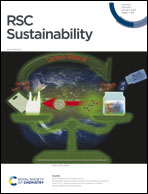Recycling post-consumer PLA into acrylic acid or lactide using phosphonium ionic liquids†
Abstract
Chemical recycling of polymer waste to the original monomer (CRM) forms an important concept for a circular plastic economy. For poly(lactic acid) (PLA) this is often neglected as a result of PLA's known biodegradability. However, such degradation leads to the undesired generation of CO2, associated with a poor energy efficiency and a missed opportunity for fast circular reuse. In this work, we develop a system to recycle post-consumer PLA into either acrylic acid (AA) or lactide (LAC), depending on the presence/absence of an acidic cocatalyst and the applied reaction conditions. A detailed time profile showed that PLA is first converted into LAC and subsequently rearranged to AA under acidic conditions. Up to 50% of monomer yield was achieved in a single step, using a phosphonium ionic liquid (Bu4PBr) as the active solvent and only 5 mol% of organic cocatalyst.



 Please wait while we load your content...
Please wait while we load your content...